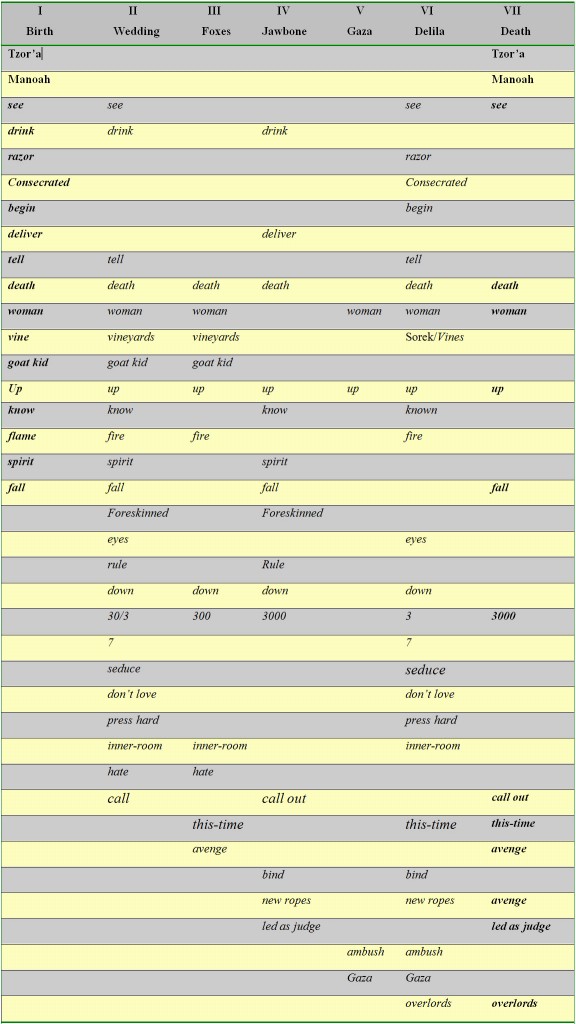Appendix: The Sound and Structure of a Biblical Tale
The stories about Shimshon constitute an outstanding example of narrative art in the Bible. Although Judges 13-16 has sometimes been viewed as a loosely gathered series of tales about the hero (Brettler), it in fact exhibits a verbally tight structure, possibly indicating oral origins. More than perhaps any other cycle of stories in the Bible, it is built architectonically on the repetition of words and motifs. I have presented a list of these below. More could be adduced, but this sampling of thirty-eight elements will, I think, be sufficient to make the point that the entire cycle of stories has been carefully built up and knit together by means of repetition.
This technique, as many have observed, is one of the classic building blocks of biblical narrative, but the Shimshon material goes beyond its conventional use. Here, instead of simply using several key words or phrases to suggest important concerns in the text, we are treated to a stunning piece of ancient literary architecture. The storyteller, or, just as likely, a series of storytellers and creative “redactors,” has connected different episodes in a dizzying set of combinations. The fourth episode, for example, picks up twelve elements that have already appeared in the previous sections, but it also introduces three new ones of its own. Almost half of the words/ideas in the cycle make their first appearance in episode I; but it is episode VI, the Delila story, that contains the most of any single section in the text: twenty-four.
What this means is that the story of Shimshon and Delila, arguably the most famous section of the cycle and one that is unforgettable in its tension and dialogical richness, is constructed overwhelmingly out of pieces that have already been given to the audience. The previous five episodes have, as it were, paved the way for what is to come, contributing their building materials to the most important edifice. In the Delila account, everything comes together: strength, secrets, women, and enemies, but something new appears as well. For the first time, Shimshon himself acknowledges his special status as a “Consecrated One” (nazir).
The example of the Shimshon cycle is an important one for understanding biblical narrative, for it demonstrates that, whatever the origin of the discrete pieces of the story, its present form has been tightly and beautifully woven together by means of sound. An ancient audience would no doubt have appreciated the story’s artistry, in conjunction with its humor, its irony, and its didactic intent.
The episodes in the chart below are as follows: Birth=13:2-25, Wedding=II-14:1-20, Foxes=15:1-8, Jawbone=15:9-20, Gaza=16:1-3, Delila=16:4-22, Death=16:23-31.

The basic structural characteristic of the cycle is that scene by scene, new elements are consistently added, while a liberal selection of older ones is retained. Episode II adds eleven; episode III, two; episode IV, three; episode V, two; and episode six, likewise one. The final two scenes reprise thirty out of the thirty-eight elements, and even most of the missing ones (for instance, “deliver,” “spirit,” “foreskinned-ones”/Philistine rule) are implied. They serve to bring together all the great facets of the farce-drama that is the Shimshon cycle: seeing and enticing, knowing and telling, deliverance and death. Thus viewed, chapter 16, far from being a separate set of tales, integrates what has come before in a sophisticated and spectacular display of the Hebrew Bible’s narrative artistry.